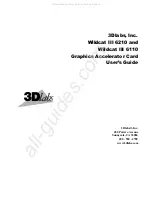
Dialogic PCI Linecard Installation and Replacement
R3B
ã
Aug 2001 Ericsson Enterprise AB
20
Many PBXs have built-in CSUs or CSU-like functions. The D/240PCI-T1 can connect
directly to these devices provided that the PBX has a DSX-1 interface (the D/240PCI-T1
will not respond to loopback commands when connected this way). See your switch or
PBX documentation to confirm that your equipment has the necessary features.
Although the D/240PCI-T1 and some PBXs have built-in CSU functions, some carriers
require a CSU to be present so that they can perform diagnostics on the T-1 line. Always
consult with your carrier for its requirements.
T-1 Line–to–CSU Cable
T-1 connectors vary from carrier to carrier, but the cable provided by the T-1 carrier
usually consists of two pairs of individually shielded twisted 22-gauge wires (one
transmit pair and one receive pair) terminated in either a DB-15 or modular RJ-48C plug.
When you order service, make sure that the type of plug the carrier provides is compatible
with the type of plug your CSU accepts. Older CSUs may require that you connect the
wires directly to a terminal strip or similar arrangement. Refer to your CSU
documentation for more information.
Wet or Dry T-1
T-1 lines that carry a voltage to power regenerative repeaters are called
wet T-1
. This
voltage traditionally has also been used to power the CSU at a site. Since 1987, the
Federal Communications Commission no longer requires the carrier to provide line
power, and the trend has been to discontinue its use. T-1 lines without power are called
dry T-1
. If your carrier provides dry T-1, then your CSU must have an AC power source.
Check with your carrier to see what kind of line they supply so that you can obtain an
appropriate CSU. Many of the latest CSUs can handle either kind of line.
CSU–to–D/240PCI-T1 Adapter Cable
The D/240PCI-T1 has an RJ-48C connector on the rear bracket. To connect this linecard
to the CSU you can purchase a CSU-to-equipment adapter cable or build one yourself.
The recommended material for the cable is shielded twisted-pair (ABAM 600 or
equivalent) in which each of the two pairs is shielded and the two pairs share a common
shield. This type of shielding helps to avoid crosstalk problems on the line.
Choose an appropriate cable length for your installation. Eighty-five feet (approximately
26 meters) is the maximum recommended cable length between the CSU and the
D/240PCI-T1 for standard T-1 signals (6 volts peak to peak). In general, you should keep
the cable length as short as possible. Refer to your CSU documentation for guidelines
concerning cable lengths greater than 85 feet (26 meters).
















































